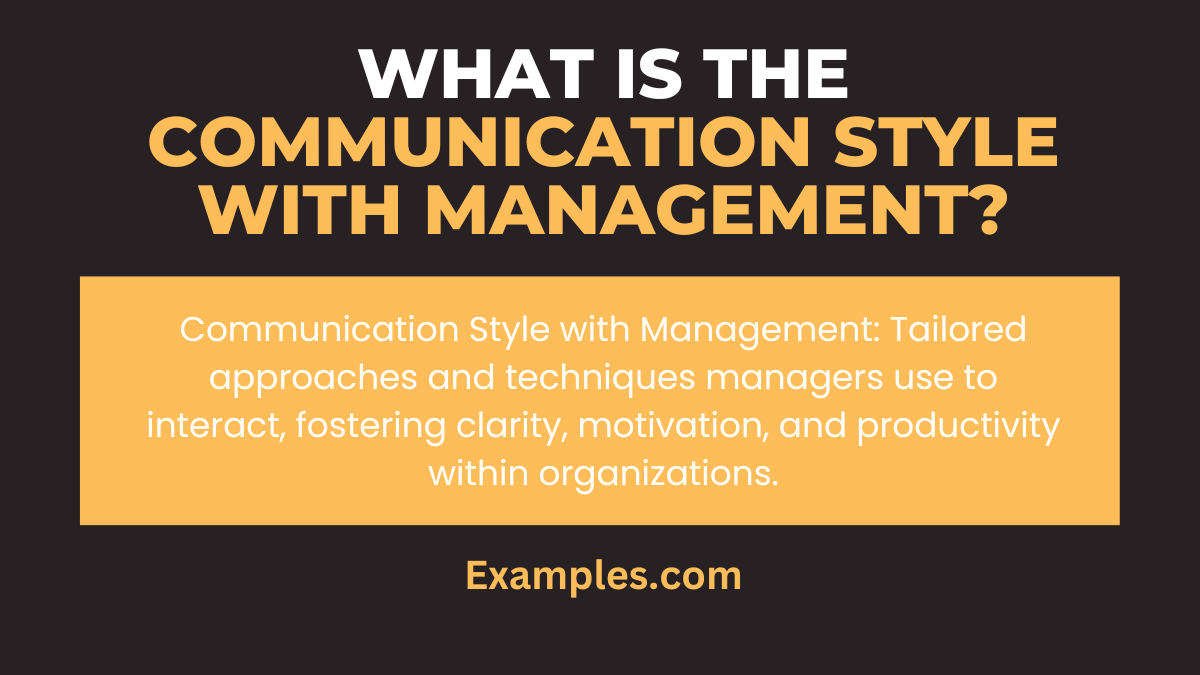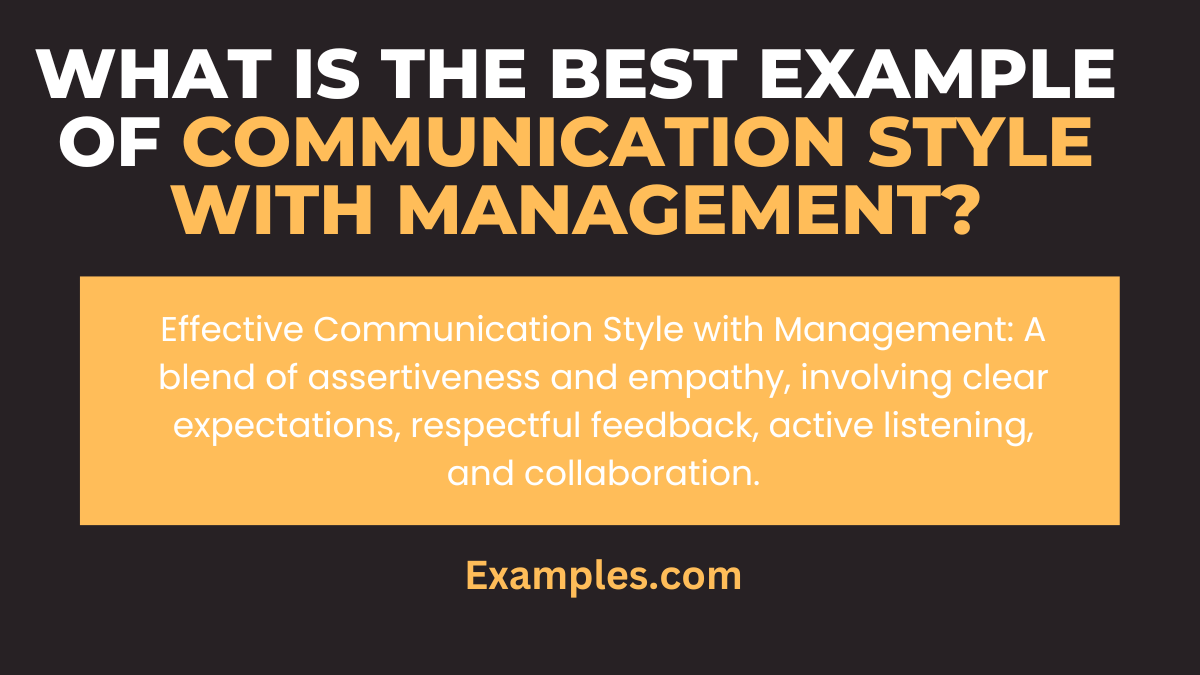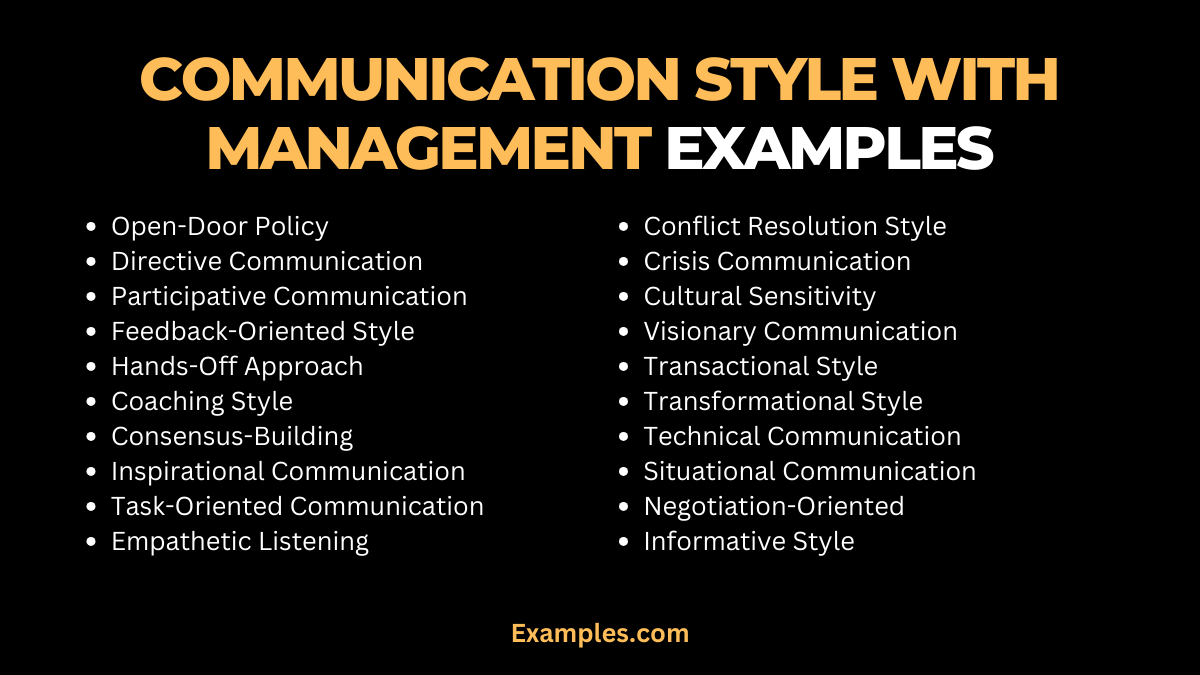19+ Communication Style with Management Examples
Explore the realm of effective leadership through our comprehensive guide on Communication Style with Management. Delve into various strategies, techniques, and real-life Communication Examples to elevate your managerial communication. This introduction will pave the way for understanding the intricate dynamics of Leadership Communication Styles, ensuring your managerial approach is both impactful and informed.
What is the Communication Style with Management? – Meaning

Communication Style with Management refers to the distinct ways managers interact with their team members and other stakeholders. It encompasses the approach, tone, and techniques used in exchanging information and making decisions. Effective management communication is tailored to various situations, promoting clarity, motivation, and understanding within the workplace. It’s about adapting and optimizing interactions to foster a productive and positive organizational environment.
What is the Best Example of Communication Style with Management?

The best example of Communication Style with Management often involves a blend of assertive and empathetic communication. This style is characterized by a manager who clearly and respectfully conveys expectations, feedback, and strategies while also actively listening to and valuing team members’ input. For instance, a manager might address a team’s concerns about a project by openly discussing challenges and collaboratively developing solutions. This approach not only ensures that the objectives are understood and met but also builds a supportive and motivated team environment.
20 Communication Style with Management Examples

Discover the various facets of managerial communication with our detailed guide on 20 Communication Style with Management examples. Each example is crafted to provide insights into different communication scenarios, highlighting the causes and offering practical solutions. From Assertive Communication Style with management to analytical communication style, ensuring a comprehensive understanding of effective management communication. Enhance your leadership skills with these tailored examples, perfect for fostering a thriving workplace environment.
- Open-Door Policy: Causes: A desire for transparency and approachability. Fix: Encourage regular, informal interactions to build trust.
- Directive Communication: Causes: Time constraints, high-pressure situations. Fix: Balance with supportive language to avoid seeming too authoritative.
- Participative Communication: Causes: Valuing team input and collaboration. Fix: Ensure clear decision-making processes to avoid confusion.
- Feedback-Oriented Style: Causes: Focus on continuous improvement. Fix: Provide specific, constructive feedback and encourage reciprocation.
- Hands-Off Approach: Causes: Trust in team’s abilities. Fix: Regular check-ins to offer guidance without micromanaging.
- Coaching Style: Causes: Development-focused mindset. Fix: Set clear goals and provide resources for team development.
- Consensus-Building: Causes: Democratic leadership values. Fix: Facilitate discussions while steering towards productive outcomes.
- Inspirational Communication: Causes: Motivating team towards a vision. Fix: Align messages with team values and goals.
- Task-Oriented Communication: Causes: Prioritizing efficiency and productivity. Fix: Balance task focus with attention to team well-being.
- Empathetic Listening: Causes: Building strong relationships. Fix: Active listening and validating team members’ perspectives.
- Conflict Resolution Style: Causes: Addressing disagreements constructively. Fix: Mediate with neutrality and promote collaborative solutions.
- Crisis Communication: Causes: Managing unexpected challenges. Fix: Maintain calm, provide clear directives, and be transparent.
- Cultural Sensitivity: Causes: Diverse team dynamics. Fix: Educate oneself on cultural nuances and adapt communication accordingly.
- Visionary Communication: Causes: Leading with a long-term perspective. Fix: Communicate the vision clearly and connect it with daily tasks.
- Transactional Style: Causes: Focus on exchanges and agreements. Fix: Ensure clarity in expectations and rewards.
- Transformational Style: Causes: Inspiring change and innovation. Fix: Foster an environment that encourages creativity and risk-taking.
- Technical Communication: Causes: Dealing with specialized knowledge. Fix: Simplify complex information and relate it to practical applications.
- Situational Communication: Causes: Adapting to varying scenarios. Fix: Develop a flexible communication approach suited to different contexts.
- Negotiation-Oriented: Causes: Reaching agreements and compromises. Fix: Practice active listening and aim for win-win outcomes.
- Informative Style: Causes: Prioritizing knowledge sharing. Fix: Ensure information is relevant, accessible, and comprehensible to all team members.
Analytical Communication Style with Management
An Analytical Communication Style in management involves a precise and structured approach, focusing on data and facts to guide discussions and decisions. Ideal for settings requiring detailed analysis and critical thinking, it’s part of the various Types of Communication Styles crucial in different workplace scenarios.
- Detailing a Project Plan: Incorporate comprehensive data analysis to enhance project planning and execution.
- Evaluating Team Performance: Utilize specific metrics to assess and communicate team productivity and areas for growth.
- Interpreting Market Research: Discuss intricate market trends and their implications with a focus on empirical data.
- Budget Analysis: Convey budgetary considerations with clear, data-backed explanations.
- Strategic Problem Solving: Employ logical reasoning to navigate and communicate complex strategic challenges.
Download Business Communication Style with Management PDF
Communication Style with Management Leadership
Leadership requires a dynamic and adaptive Communication Style, often blending various approaches like assertive communication style and reflective communication style to effectively guide and motivate a team. This style is pivotal in establishing a leader’s presence and fostering a productive environment.
- Vision Casting: Articulate a compelling future vision, employing a Reflective Communication Style to connect on a deeper level.
- Motivational Speaking: Use an assertive yet Open Communication Style to encourage and motivate team members towards goals.
- Feedback Sessions: Provide clear, constructive feedback using a balanced and empathetic approach.
- Managing Transitions: Communicate necessary changes assertively and supportively, considering team sentiments and feedback.
- Relationship Building: Engage in meaningful conversations that foster strong relationships within the team.
Assertive Communication Style with Management
The Assertive Communication Style is often viewed as the most desirable in management due to its effectiveness in expressing clear, respectful, and direct messages. It strikes a balance between passive and aggressive styles, ensuring a productive and harmonious workplace.
- Setting Clear Objectives: Convey goals and expectations directly, ensuring clarity and alignment.
- Resolving Conflicts: Address issues promptly and firmly, promoting fair and constructive resolutions.
- Delegating Tasks: Assign responsibilities clearly and confidently, respecting individual capabilities and workload.
- Encouraging Feedback: Invite and provide feedback in a manner that is direct yet considerate of others’ feelings.
- Decision Making: Communicate decisions firmly, providing clear rationale and encouraging team support.
Communication Style with Management in Project
Effective communication in project management is pivotal for success and involves a strategic blend of styles to navigate diverse team dynamics and project challenges. Explore detailed strategies and insights on Effective Project Management, learn about various communication methods in project Each offers valuable, authoritative information on enhancing Communication Pattern for project managers.
What are the Different Communication Styles with Management?
Understanding the different communication styles with management is crucial for effective leadership and team dynamics. These styles can significantly impact how managers lead, motivate, and engage with their teams and stakeholders.
- Directive Style: Often used in high-pressure situations or when clear instructions are needed. This style is straightforward and authoritative, suitable for Communication Style for Project Managers and Leaders.
- Consultative Style: Involves seeking input and encouraging participation from team members. It’s collaborative, making it a go-to for Communication Style for Coaching and team building.
- Participative Style: Managers and team members make decisions together, fostering a democratic and inclusive environment. Ideal for Communication Style for Relationships within the team.
- Expressive Style: Characterized by enthusiasm and persuasiveness, great for motivating and engaging teams, often seen in Communication Style for Influencers.
- Reflective Style: Involves analysis and careful consideration before communicating, suitable for Communication Style for Students and professionals in detailed-oriented roles.
What is the Purpose of Communication Style with Management?
The purpose of communication style with management is to facilitate effective interaction that leads to efficient decision-making, problem-solving, and relationship-building within an organization.
- Ensuring Clarity and Direction: Directive styles provide clear instructions, important for Communication Style for Work where precision is key.
- Encouraging Team Input: Consultative and participative styles promote collaboration and idea sharing, enhancing Communication Style for Leaders.
- Motivating and Inspiring: Expressive styles are great for motivation and morale boosting, crucial for Communication Style for Influencer roles.
- Making Informed Decisions: Reflective styles allow for thoughtful analysis, beneficial in Communication Style for Managers and decision-makers.
- Building Relationships: All styles contribute to relationship-building, but participative and consultative styles are particularly effective in creating strong Communication Style in Relationships.
Why are Communication Styles with Management Important in the Workplace?
Effective communication styles with management are crucial for clarity, team morale, and productivity, ensuring a harmonious and efficient workplace.
What is the Communication Approach in Management?
The communication approach in management involves strategies and methods used to convey messages and engage teams effectively, often enhanced by Communication Style Assessment.
What is the Impact of Communication Style with Management?
The impact of communication style with management includes improved team collaboration, better conflict resolution, and enhanced overall workplace atmosphere, critical for leadership success.
In conclusion, effective communication style with management is vital for fostering a productive and positive workplace. It influences team dynamics, decision-making, and conflict resolution. Recognizing and adapting communication styles can lead to improved understanding, stronger relationships, and better leadership. For lasting impact, continually assess and refine your approach to ensure it aligns with team needs and organizational goals.



